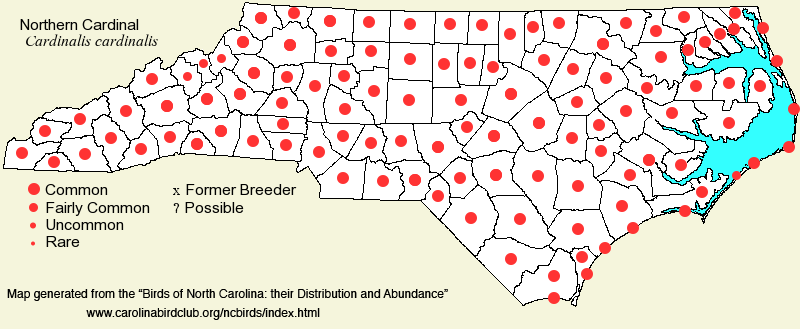 |  |
|
Northern Cardinal - Cardinalis cardinalis CARDINALIDAE Members: | Search Common: Search Scientific: |
|
|
|||||||
| General Comments | The Northern Cardinal, the Official State Bird of North Carolina, needs no introduction. It occurs over nearly all of the eastern half of the United States, plus in the Southwest. It is common to abundant across the entire state at all seasons, and it is essentially non-migratory, though birds move locally to form flocks up to 20 birds or more, on occasions, in winter. It is an avid feeder visitor, and the male Cardinal seen against a snowy background is always a winter highlight. They breed in a wide array of habitats with some moderate shrubby/understory cover -- most forests and woodlands, wooded borders, residential areas, and sparingly into younger clearcuts and regenerating forests. In winter, when many hardwood forests are devoid or scarce of cover, Cardinals move to thickets, wooded edges, densely weedy fields, etc., but also remain in wooded residential areas and in other forests with evergreen shrub cover. | ||||||
| Breeding Status | Breeder | ||||||
| NC BRC List | Definitive | ||||||
| State Status | |||||||
| U.S. Status | |||||||
| State Rank | S5 | ||||||
| Global Rank | G5 | ||||||
| Coastal Plain | Permanent resident, essentially non-migratory. Very common throughout, though slightly less numerous on some coastal islands. Peak counts: | ||||||
| Piedmont | Permanent resident, essentially non-migratory. Very common throughout. Peak counts: 1,001, Chapel Hill spring count, 12 May 2002. | ||||||
| Mountains | Permanent resident, essentially non-migratory. Common to very common in the lower elevations, to about 3,000 feet; fairly common to uncommon to about 4,000 feet, and rarely much higher. Slightly less numerous at middle and higher elevations in winter. Peak counts: | ||||||
| Finding Tips |
None needed. **** | ||||||
| Attribution | LeGrand[2012-11-06], LeGrand[2011-12-18], LeGrand[2011-10-08] | ||||||
| NC Map Map depicts all counties with a report (transient or resident) for the species. | Click on county for list of all known species. |
| NC Breeding Season Map Map depicts assumed breeding season abundance for the species. |  |